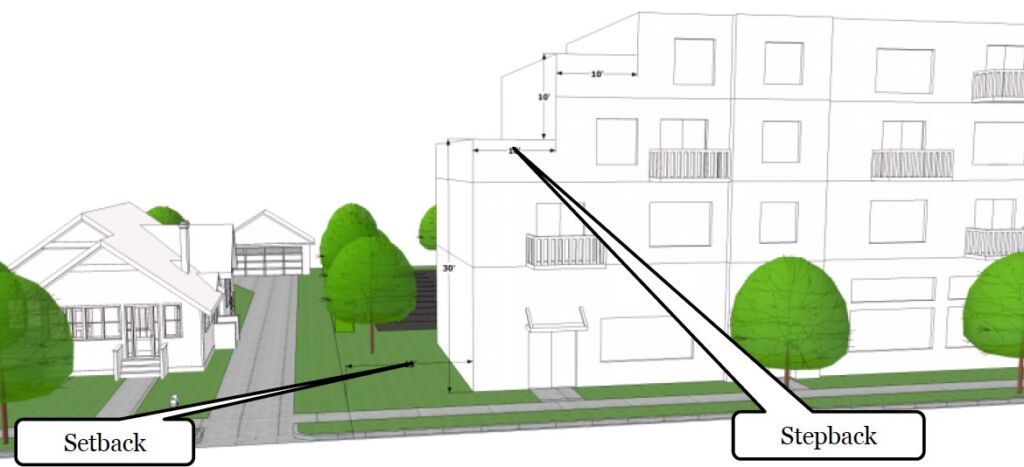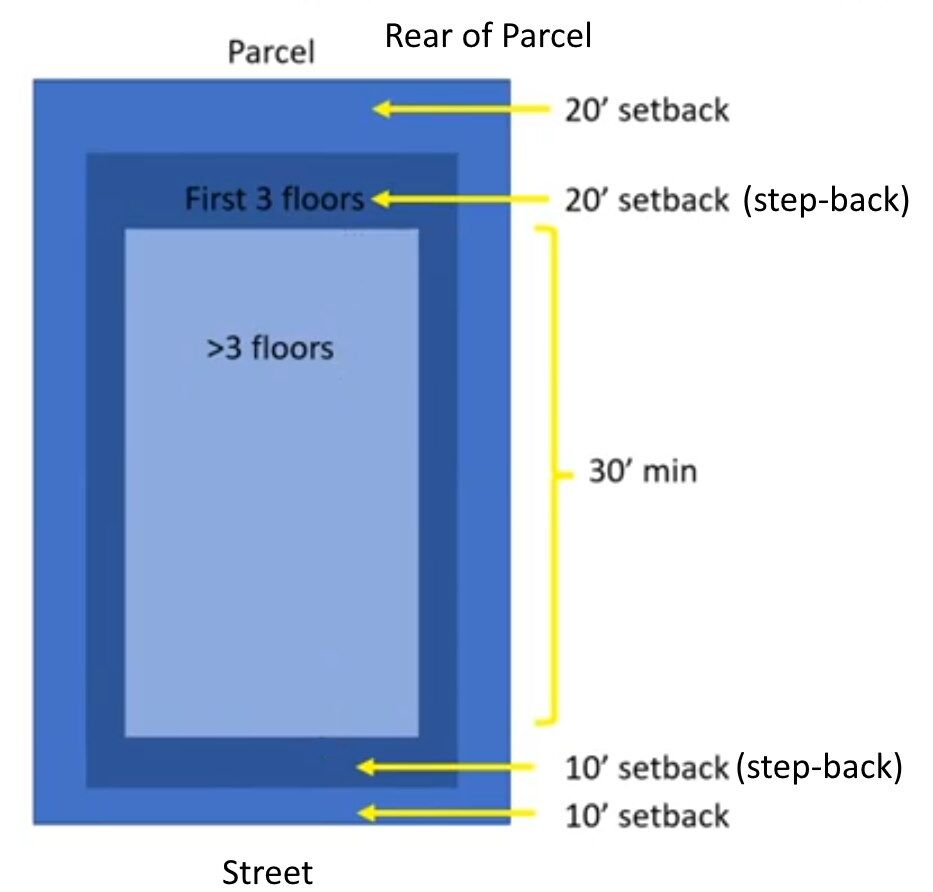During the past more than one-and-a-half years of discussion on the draft Gateway Plan, we’ve seen a variety of important aspects of the plan come and go. Critical issues that many of us thought were “done deals” seemed to have arrived as firm promises and later vanished like smoke following a Planning Commission conversation of just a minute or two. Or vanished with no conversation whatsoever.
One important and integral item is the explicit promise of inclusionary zoning. Even though there are words in the Gateway code under the heading of “Inclusionary Zoning,” the code for this is so weakened that there is no practical value to it. To put it more bluntly, the inclusionary zoning clause that’s there is worthless. Further, the clause appears to have been worded in such as way so as to make it worthless. To read more on this, see After telling the Council we’ll see Inclusionary Zoning, what Loya has provided is worthless.
Decent set-backs and step-backs get the axe
Another area that’s near and dear to the hearts of Arcatans are the set-back and step-back requirements for new buildings. The set-back (or “setback”) is the distance from the property line where the building could be placed. The step-back (or “stepback”) can be a requirement for the upper stories.
Rather than having a wall of the building going straight up for four or five or six or seven stories, if an upper floor is stepped back from the wall of the building it will create a a more pleasant experience for the people on the street below, and for buildings on adjoining parcels. If done right, upper floor step-backs will provide more of a “blue sky” view for pedestrians and cyclists, and potentially less solar shading from the building. Step-backs also generally make for a more architecturally interesting design.
Setbacks and stepbacks can be specified as being different for the front side (street), the back side (rear of the property), and the side property lines.
- Front setback: From the street to where the building starts. Provides space for a sidewalk.
- Rear setback: How close the new building is to the property line. If too close, the new building will adversely affect the neighbor. A setback of Zero feet means that the building can be on the property line.
- Front stepback: How the building is “stepped back” on the upper stories.
- Rear stepback: The same, at the rear of the building.


In the image above, there are two stepbacks shown. The setback is 10 feet from the side property line. Then there’s one 10-foot setback at the 3-1/2 story mark, then another 10 feet back at the 4-1/2 story level. The result is plenty of light for the single-family home on the parcel to the left.
Below is from the Marin County form-based code. The buildings shown have a big enough street setback to provide a plaza-like feel. There are upper story stepbacks above the 4th floor large enough for a patio. The upper floor stepbacks are large enough that the top story — the 5th story — cannot be seen from the street. 
David Loya presented a concept for the St. Vinnie’s site
In the 9-1/2 minute video presentation “Building and Massing Presentation 3: Proposed Setbacks and Massing Impacts” — available with the transcription here on Arcata1.com and very recommended — Arcata’s Community Development Director David Loya proposed some setback and stepback standards.
At about 4 minutes into the video, David Loya says “Before you start a development that’s going to be five stories tall you’re going to want some pretty significant setbacks. So let’s put a 20 foot setback on the ground level — before you start building, you have to have at least 20 feet setback. We’ve talked about upper floor setbacks. I think it’s appropriate to evaluate 20 feet as an upper floor setback.”
Here’s the image showing his proposed setbacks and stepbacks. At that time (August 2022) David Loya was not yet using the word “stepbacks” — so what he is calling an upper-story “setback” what we now call an upper story step-back. Same thing, with different wording. “Step-back” is more clear, so that’s what we use now. Here’s a view of the parcel, as if it were a map and we are looking down on it. The street side of the parcel is at the bottom of this image, and the rear of the parcel is at the top of the image.
 Here we see:
Here we see:
- A 10-foot front setback.
- A 10-foot front stepback above the 3rd story.
- A 20-foot rear setback.
- A 20-foot rear stepback above the 3rd story.
- A 15-foot side setback.
- A 10-foot side stepback above the 3rd story.
At about 6 minutes into the video, he shows us a theoretical building that could be designed to fit the old St. Vincent de Paul thrift store site at 6th and K Streets. We’ll note that the front of the building is on the fairly busy K Street major artery, and that the the rear of the building site adjoins a parcel with a home that has a residential story above a garage (2 story height) for half the building and single-story residential behind that, plus a single-story single-family residence.
 Note the large stepbacks at the rear of the building, so that it has less impact on the buildings on the adjoining parcel. This theoretical building is 4 stories along K Street and then tapers down to 1 and 2 stories at the rear of the property. Note also that it is not built to the property lines at the sides or at the rear.
Note the large stepbacks at the rear of the building, so that it has less impact on the buildings on the adjoining parcel. This theoretical building is 4 stories along K Street and then tapers down to 1 and 2 stories at the rear of the property. Note also that it is not built to the property lines at the sides or at the rear.
For the building on the other side of the street on K Street, we can note the very deep stepbacks after the 3rd story, and then more stepbacks after the 4th story. Perhaps a rooftop garden or roof patio design.
The new Form-Based Code specifications for the St. Vinnie’s site


The Results: What could a developer build on this K Street parcel?

And this is what could be built:
 Here’s what the Form-Based Code and the new proposals would allow. Limited front setback. Can build right up to the property lines at the sides and rear. New proposal to have no upper floor stepbacks. Five stories, straight up, no stepbacks.
Here’s what the Form-Based Code and the new proposals would allow. Limited front setback. Can build right up to the property lines at the sides and rear. New proposal to have no upper floor stepbacks. Five stories, straight up, no stepbacks.
Relative to what we saw in August 2022


